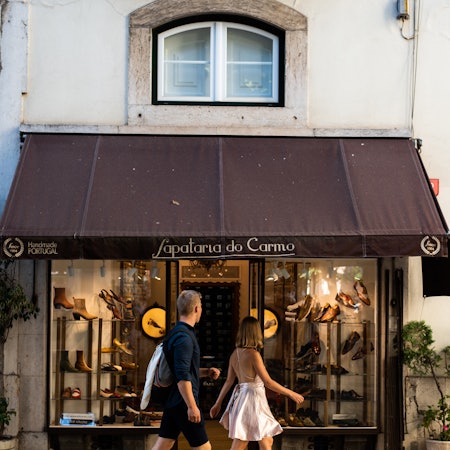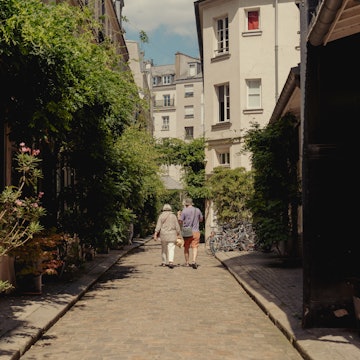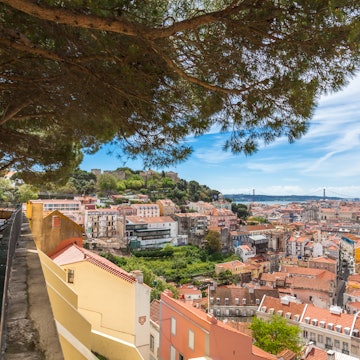

Príncipe Real is a trendy, leafy neighborhood in Lisbon. Kerry Murray for Lonely Planet.
Spread across seven undulating hillsides and filled with charming cobbled streets, beautiful Lisbon is breathtaking in every way (those hills...).
And though it may be tempting to stay central as you follow colorful clusters of buildings down to the banks of the Tagus River, exploring the city's neighborhoods will greatly enrich your experience.
A few days might be enough to tick off many must-see sights in Lisbon, but don’t rush the journey. Instead, take in the atmosphere of Lisbon’s neighborhoods one block at a time and discover a multitude of reasons to keep coming back for more.

1. Belém
Best neighborhood for day trips to the beach
With sprawling manicured gardens, expansive riverside squares and Manueline-style monuments honoring the seafaring voyagers of the 15th century, Belém often gets the attention of travelers for no longer than a day. For those on a short visit, it doesn’t take more than a morning to visit Mosteiro dos Jerónimos, Padrão dos Descobrimentos and Torre de Belém, including a pit stop at Pastéis de Belém for the famous custard tart – best eaten straight-from-the-oven, warm and sprinkled with cinnamon.
But this Lisbon neighborhood, once the suburban summer refuge of royals, has an ideal – and often overlooked – location for those who want to wind down from their urban exploration with time at the beach. Either take the ferry across the river to Trafaria, and a bus from there to the beaches at Costa da Caparica, or hop on the train to Carcavelos. Riverside cafes and restaurants cater mostly to tourists, but Lisbon’s city center is just a 10-minute train ride away if you’re looking for more variety and eating spots with a local feel.
Where to stay: Wine & Books Hotel ($$$) is a culture-driven five-star hotel in Belém near Mosteiro dos Jerónimos. Or, try Altis Belém ($$$), a five-star hotel with contemporary decor and views to Rio Tejo. Breakfast is included, and the hotel has one of the best bars and high-end restaurants in the city.


2. Madragoa, Santos and Alcântara
Best neighborhoods for digital nomads and slow travelers
If you ask locals where Santos ends and Madragoa begins, you’ll rarely get the same answer. Madragoa and Santos are usually bundled together as one neighborhood, and no one seems to mind them being referred to as a single place. Offices, schools, pretty cafes with decent and free wi-fi, a mix of traditional and modern restaurants, and the vibe of a typical Lisbon neighborhood are the gist of the Santos/Madragoa duo: bustling business area by day and quiet residential neighborhood after office hours.
Fully equipped and furnished short-term rental apartments and a cluster of coworking spaces a short walk or train ride away in nearby Cais do Sodré and Baixa-Chiado have turned Santos and Madragoa into a coveted spot for digital nomads. Fairly well-served by public transit, grocery stores, affordable cafes and restaurants, it’s the place to stay for travelers looking for a slice of local Lisbon life.
Nearby industrial and business-oriented Alcântara has turned a bridge and an old factory into tourist attractions and old warehouses into bars, nightclubs and restaurants. Roam the streets and take in tourist-centered businesses, family-owned establishments, riverside bars and cobblestoned backstreets with laundry hanging out to dry.
Where to stay: LX Hostel ($) is a stylish accommodation offering mixed and female-only dorms, as well as private rooms, located in the heart of LX Factory. It is pet-friendly, features a rooftop bar, and includes breakfast in the stay. Just across the street from the Museu Nacional de Arte Antiga is the Emerald House ($$), a four-star hotel known for its beautifully decorated rooms. If you're looking for the "wow factor" the Palácio Ramalhete ($$$), one of Lisbon’s most popular five-star design hotels, is located inside a 17th-century palace.


3. Baixa, Chiado and Rossio
Best neighborhoods for shopping
All the historical and cultural layers of Lisbon overlap here. Take the time to stroll through the post-1755 earthquake restructure of Baixa, discover hilly Chiado and its picturesque squares, and enjoy the wavy black-and-white patterns of calçada portuguesa (Portuguese cobblestone pavement) in Rossio. To fully see the contrast between these neighborhoods, head to the viewpoint at the top of Arco da Rua Augusta.
After a morning of sightseeing, go window shopping or buy some souvenirs. At Baixa’s main street, Rua Augusta, you’ll find traditional stores coexisting with tourist traps overflowing with cheap fridge magnets. Rossio is all about big plazas and their statues, flanked by overpriced souvenir shops with a few local gems thrown in the mix, like the 19th-century hattery Azevedo Rua. Chiado has the old-town charm of historical cafes like A Brasileira and Pastelaria Benard, ideal for a break after perusing the upscale shops at Rua Garrett.
These touristy neighborhoods have Lisbon’s densest concentration of hotels, hostels, cafes, restaurants and shops, making them the best areas to stay when visiting Lisbon. Travelers have direct access to two Metro lines (Blue and Green), the urban train to Sintra, and myriad buses and trams. Historic neighborhoods and top landmarks are a short – but uphill – walk away.
Where to stay: In Baixa, Home Lisbon Hostel ($) provides budget-friendly accommodation and holds the prestigious title of being rated the world's best hostel for four consecutive years. Just nearby is My Story Figueira ($$), which seamlessly integrates its architecture with the lively Praça da Figueira across the street. Families can opt for the Martinhal Lisbon Chiado Family Suites ($$$), a luxury apartment-hotel that provides babysitting services and activities for children in the vibrant core of Chiado.


4. Mouraria and Alfama
Best neighborhoods for history and sightseeing
The neighborhood of Mouraria has narrow streets flanked by full-to-the-brim stores (where you can buy everything from power adapters to spices in bulk), traditional restaurants busy at lunchtime, and locals speaking dozens of languages. In Alfama, you’ll find sunlit terraces, terracotta rooftops and Lisbon’s most famous viewpoints.
These two neighborhoods are the oldest in Lisbon and the heart of the city. You'll find top landmarks here, including Sé de Lisboa, Museu do Aljube, Museu do Teatro Romano, Castelo de São Jorge and Panteão Nacional. But the real magic happens as you wander through the cobblestoned streets, up and down the hills, getting lost amid tiled buildings, interior courtyards and pieces of Lisbon's medieval walls.
Stay here if you want a hint of old-town authenticity and don’t mind tourist crowds and fewer transportation options. Both neighborhoods are best explored on foot, with the occasional hop onto one of the classic yellow trams to dodge a steeper hill.
Where to stay: Hotel Mundial ($$) is located in Mouraria near Praça Martim Moniz and has one of the city’s most popular rooftop bars. For something a bit different, try Patio São Vicente Guest Houses ($$) with independent cottage houses and a private interior courtyard. Or go all out at Palacete Chafariz d’El Rei ($$$), perhaps Lisbon’s most beautiful five-star boutique hotel.


5. Bairro Alto, Príncipe Real and Cais do Sodré
Best neighborhoods for restaurants and nightlife
Weekend crowds flow between Bairro Alto and Cais do Sodré, seeking out the next bar stop. If you want to do as locals do, start with dinner and bar-hopping in Bairro Alto and then head downhill to the nightclubs at Cais do Sodré closer to last call (usually around 2am).
Bairro Alto is the more charismatic of the two neighborhoods, with patrons gathering outside tiny bars with a drink in hand before heading off to wherever the night leads them. In the post-democratic revolution of 1980s Lisbon, this district became the city’s bohemian destination, where students and artists flocked, yearning for the musical and intellectual freedom that thrived here after five decades of a conservative dictatorship. Although things have changed a bit since then, BA (for short) is still seen as Lisbon's affordable, unpretentious night-out spot.
Further north is Príncipe Real, a fashionable, affluent area with great restaurants, trendy cafes, and sophisticated bars. It's leafy with Lisbon's botanical gardens and the romantic Jardim do Príncipe Real all within its boundaries. The neighborhood has become known for its concept stores and design shops too.
On the other hand, Cais do Sodré is Lisbon reinvented. Once a shabby haunt for on-leave sailors, cheap and sketchy bars were the norm. These days, only the old names and decor of those places exist, a nod to how that part of the city went from a red-light district of sorts to one of Lisbon’s most popular nightlife districts. Pensão Amor is the best example of that past and present fusion.
Where to stay: Stay Inn Lisbon Hostel ($) is an affordable hostel, with a shared kitchen and eight brightly decorated individual rooms in the center of Bairro Alto. Dear Lisbon Gallery House ($$) is another handy option, a boutique hotel in one of the area's central streets (often called "the Triangle"), with uniquely designed rooms. The five-star Corpo Santo Hotel ($$$) is a stunning option in Cais do Sodré, with its reading room that incorporates a preserved portion of a 14th-century city wall.

6. Parque das Nações
Best neighborhood for families
The eastern neighborhood of Parque das Nações grew around the former grounds of Expo '98, and it’s the newest part of Lisbon. Although the city center is a train or metro trip away, it doesn’t take more than 30 minutes to reach must-see attractions. The urban park itself is a great playground for kids, but the real family-friendly gems are the Oceanário de Lisboa, one of the largest aquariums in Europe, and Centro de Ciência Viva, an interactive science museum for kids and grownups where kids are allowed and encouraged to touch all displays.
Parque das Nações is one of the best neighborhoods in Lisbon for families, with big chain hotels concentrated between the park and the Oriente Station, the public transit hub for trains, metro and buses. A good mix of grocery stores, small local food shops and family-friendly restaurants like ZeroZero and Sea The Future makes it easy to plan meals before or after a day of sightseeing across town.
Where to stay: HI Lisboa – Pousada de Juventude ($) is a youth hostel with budget-friendly shared rooms and dorms close to Moscavide Metro station. Olissippo Oriente ($$) is a central and affordable four-star hotel, close to the neighborhood's major sites and public transit. At the higher end of the scale is Myriad by SANA ($$$), a luxury hotel in Parque das Nações most iconic building: Torre Vasco da Gama.
















